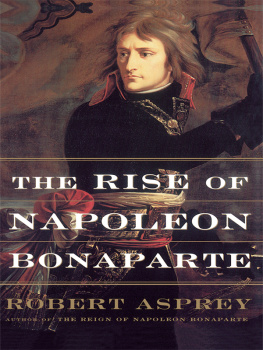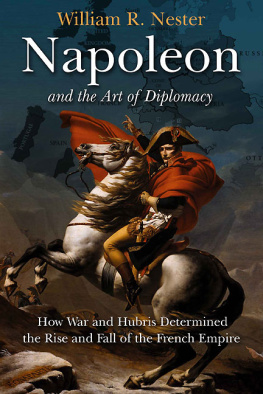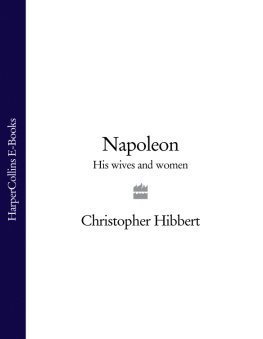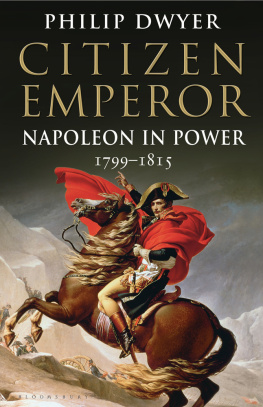
For my father, Francis Matthew Dwyer
Contents
Napoleon Bonaparte was christened Napoleone di Buonaparte and was known by that name for the first two decades of his life; his first name was also sometimes spelled Nabulio, Nabulione, Napulione or Napolionne. The name is unusual and its origins are obscure, although he was probably named after his fathers uncle, who died a year before Napoleones birth. For the purposes of this book, I have used Napoleone in the passages dealing with his youth, and then Buonaparte once he graduates from the military academy in Paris. Similarly, I have kept the Corsican versions of the names of the Buonaparte family for the early stages. For example, Joseph the future King of Spain is referred to as Giuseppe, Louis the future King of Holland as Luigi, and so on. It was only after the Buonaparte family was definitively installed in France in 1793 that they began to adopt French versions of their names. After marrying Josephine in 1796, Napoleone di Buonaparte changed the spelling of his name to Napoleon Bonaparte, and, therefore, from that moment on, I refer to him as simply Bonaparte (which Josephine called him all her life). Where he is referred to as Napoleon, it is generally a reference to the period after 1804.
Napoleon is one of those figures whose legend is so persistent that it often confounds historical reality, especially in the popular imagination. Indeed, Napoleon contributed much towards constructing his own myth, from his youth even until after he fell from power, when, while in exile, he dictated his memoirs to a group of disciples who took down his every word in the hope that his version of history would prevail. Such were Napoleons skills as a chronicler that much of the legend is still unquestioningly accepted.
One of the most blatant examples of the legend of Napoleon prevailing is in the account we have of the battle to take Arcola, a nondescript northern Italian village in a desolate setting about thirty-two kilometres east of Verona. On a bleak winters day in November 1796, French and Austrian imperial forces confronted each other, separated by the river Alpone and a small wooden bridge that was about thirty paces long and set on three stone piles. The unimposing bridge, still in its original place, is now made of concrete and metal. The road leading up to it is built up above the surrounding fields; there is a dyke on either side of the road, and also on either side of the river bank, in order to prevent the village and the surrounding fields from flooding. Crossing this bridge at the earliest possible moment was crucial to Bonapartes plan.
On the opposite side of the Alpone facing the French were two battalions of Croatians, part of the Austrian imperial army, and several cannon placed in such a way that they could fire on anyone approaching the bridge along the exposed roadway for hundreds of metres. Rather than advance, the French troops took cover behind the dykes. Some of Bonapartes leading generals Lannes, Bon, Verdier Augereau, although abandoned by his men, escaped without injury and returned to his starting point.
According to one of his aides-de-camp, Captain Joseph Sulkowski, Bonaparte decided to repeat the same heroic gesture, flag in hand:
We suddenly saw him appear on the embankment, surrounded by his general staff and followed by his guides, he dismounted, drew his sword, took the flag and rushed onto the middle of the bridge amid a rain of fire. The troops saw him but none of them imitated him. I was present at that incredible cowardice and can hardly believe it The moment was brief, but fatal for all those who surrounded Bonaparte, his aide-de-camp Muiron, general Vignolle, the lieutenant of the guides, and two of Belliards adjutants fell by his side. I myself was hit by shot, right in the chest, the rolled up coat I was carrying around my neck saved my life; but at the same time a shell exploded at my feet and hit me in the head with the earth it threw up; the blow was so violent that I lost consciousness, and when I came to I was already far from the scene, carried by troops.
Jean-Baptiste Muiron did indeed die on the bridge that day, but whether he threw himself in front of his commander to protect him from Austrian bullets is another matter. A number of other officers were killed or wounded in the attempt to take the bridge. It is remarkable that Bonaparte was not among them, and this may very well have been because the Austrians ceased fire believing that an officer was approaching them for talks.
When the Austrians opened up again, probably realizing their mistake, Bonaparte withdrew. This time everybody rushed to follow his example. The soldiers only stopped when they were out of range of the cannon. The throng was so great that, in the confusion that
This is not how the battle, described by Bonaparte as having decided the fate of Italy, or the behaviour of the French troops, was presented to the public back home. The cowardice, or common sense, depending on ones point of view, of the troops was expunged entirely from the official report. Indeed, the fact that the attempted crossing failed was discreetly forgotten.
To some extent, the narrative depends as much on what is not said as what is exaggerated. An aide-de-camp, Jean Lemarois, later repeated the official version on a visit to Paris, where he was sent by Bonaparte with the enemy flags taken at Arcola: Bonaparte was there, he gave the signal to attack and tracing out himself, with flag in hand, the path to victory to his brave companions in arms, he shook and then dispersed the fourth enemy army.
The heroic image of Bonaparte successfully charging the bridge was transformed, within a short space of time, into a propaganda cornerstone, represented in countless engravings and paintings. One of the most celebrated representations of that day, the first iconic painting of Bonaparte, is by Antoine-Jean Gros, Bonaparte at the Bridge of Arcola (see frontispiece). There is a story that Josephine forced an impatient Bonaparte to sit on her knees over breakfast while Gros made the sketches he needed.
As incongruous as this image may be, and in such trying circumstances, Gros is said to have achieved an amazing likeness of Bonaparte, at least according to one of his aides-de-camp, Antoine Lavalette, who was witness to three of the sittings. It is a deeply masculine image: Bonaparte is perfectly calm and resolute, manly, advancing towards an unseen enemy with sword in one hand, staff in the other, as the flag unfurls in the wind behind. Bonaparte does not look at the enemy, though; he looks at his own men, unseen, who, the onlooker must assume, have followed him on to the bridge. His hair, blowing in the wind, merges with the folds of the flag in the background, blurred in cannon smoke.
For Gros, it was a question of representing a particular moment and, in some ways, this painting is the eighteenth-century equivalent of a cinematic close-up in which the part explains the whole. Historical accuracy aside, it not only allowed people to recognize Bonaparte, but also to identify with him.
The French had been accustomed to worshipping a canon of great men, including philosophes and generals, celebrated in paintings
The democratization of paintings, statues and other artistic representations of public figures increased with the fall of the monarchy in 1792. Just who was represented would largely be determined by political vicissitudes or expediency. The philosophes Voltaire and Rousseau became favourites in the early stages of the Revolution and so, too, were the hero of the American Revolution, the Marquis de Lafayette, the finance minister, Jacques Necker very popular with the people of Paris and whose dismissal by Louis XVI contributed to tensions that led to the storming of the Bastille and the Comte de Mirabeau, a recalcitrant noble with a scandalous lifestyle who was one of the leading lights of the opening phases of the Revolution. Later there would be representations of radical republicans and popular demagogues, such as Jean-Paul Marat (whose newspaper, the rabid
Next page









